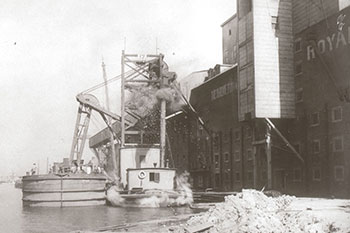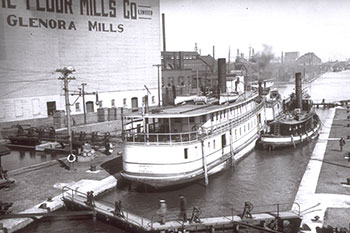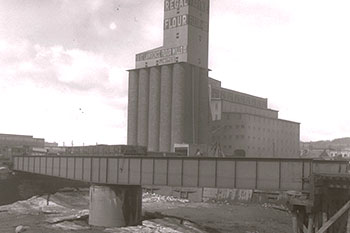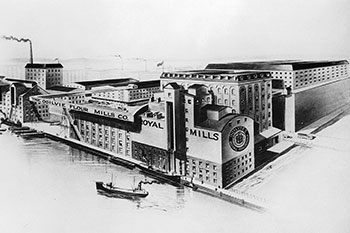
Ogilvie Flour Mill at left and the Lachine Canal during drainage, cleaning and repair for the new season, 1951. LAC PA 163164.
The History of Flour Mills and Silos at the Lachine Canal
Lachine Canal National Historic Site
Wheat and Flour

One of the goals of the promoters of the Lachine Canal project was to carry raw materials from Ontario to Montréal for reshipment to foreign markets. Wheat and flour along with wood (and, beginning in 1850, coal) were the main commodities transiting through the Lachine Canal. In fact, these products accounted for an average of 60% of the total carried over this waterway.
Although some years, such as 1845-1848, wheat and flour represented more than 75% of the freight bound for Montréal from the Great Lakes as a rule, this proportion hovered in the neighbourhood of 25%.
Until 1860, Ontario shipped more flour than grain, but from that year on, the reverse situation prevailed as wheat became by far the leading staple delivered to Montréal via the St-Lawrence Canal. This era also saw the emergence of grain warehouses in the port landscape on the Lachine canal.
The Rise of the Flour Mills

In 1848, Ira Gould created a stir in the Montréal flour mill sector when he established Coty Flour Mills on reach No. 2.
The flour mills, allowing a massive production of flour, come to compete with the already established flour mills. To meet this challenge, Ogilvie and Watson in partnership with their brother-in-law, James Goudie, and with Oglivie’s son, Alexander Walker Ogilvie, built Glenora Mills on the St. Gabriel locks in 1852, on the present site of thePointe-des-Seigneurs Archaeological Park. This alliance constitutes the beginning of a family empire without equal in the Canadian milling industry!
Positive context and competitive market

During the 1900s, the Wheat Boom in full swing in Western Canada, while a series of crop failures best in the United States. The result was an explosion Canada’s wheat and flour exports. At that time, however, Montreal, which was the nation’s grain-handling port, had only one large flour mill. Which such positive prospects before it, Montreal was witness to the emergence of two new mills –the Dominion Flour Mills (1912-1914) in St. Henri and St. Lawrence Flour Mills (1911) now known as Robin Hood Multifoods, which is still there today and located along the Lachine Canal..
In these new flour mills, wheat was washed, ground, turn into powder, bolted and bagged. In 1925, Lake of the Woods Milling Company took over Dominion Mills. Thanks to the reputation of their company brands, the three flour mills located along the canal were able to confront the harsh economic winds of the 1930s without collapsing. In accordance with the dictates of commercial rivalry Oglivie launched a cookbook to promote its brand flour. To offset the impact of this initiative, Lake of the Woods Milling Company brought out its cookbook for Five Roses flour following year. In 954, Ogilvie acquired Five Roses.
The Ogilvie empire's success

When John Watson debarked in Montreal in 1801 with only two grist stones in tow, it never occurred to him that this arrival would mark the birth of a family-owned flour-milling without equal in the British Empire.The family enterprise proved a success. In 1852, its built Glenora Mills on the St. Gabriel Locks.
In 1855, the elder shareholders turned over the reins to a new generation represented by John and A Walker Ogilvie. In 1860, their brother William Watson Ogilvie also joined us in A.W. Ogilvie and Co.
Tabling on their business relations with Canadian Pacific Railway, the Ogilvie in 1883 gained a monopoly over the silage and shipment of wheat from the West to the Great Lakes. During the same decade, the company bought up the Royal and City companies, both of which were located on the banks of the canal, and became a shareholder in Montreal Transportation.
Although the future of the family empire now lay in the West, the Montreal mills nevertheless remained Ogilvie’s flagship outfits. Incorporated in 1902, Ogilvie Flour Mills Company ranked as the largest milling company in the British Empire.
This text is taken from the book The Lachine Canal: Riding the Waves of Urban Development by Yvon Desloges and Alain Gelly, published by Les éditions du Septentrion, 2002. Pages 96, 139.
Related links
Related links
- Date modified :